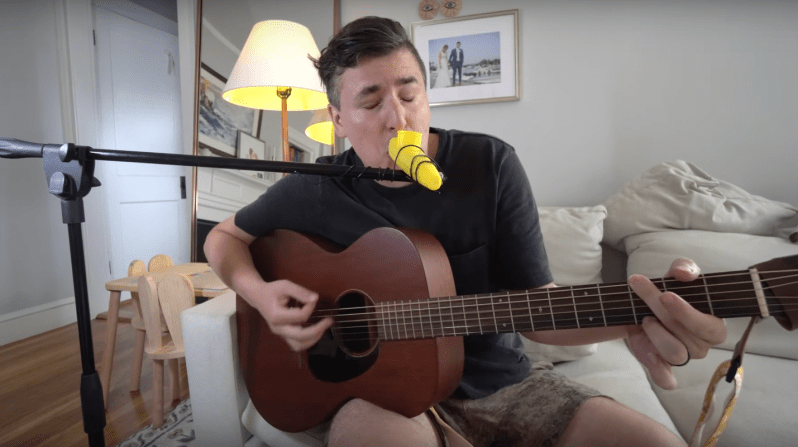Various decades have their musical signature, like the excessive use of synthesizers and hairspray in the 1980s pop music scene. Likewise, the early 2010s was marked by a fairly extreme use of autotune, a technology that allows sounds, especially vocals, to be shifted to precise pitches regardless of the pitch of the original source. In this dark era, a wide swath of instruments and voices on the charts were auto-tuned at some point, although we don’t remember this iconic instrument ever being featured among the annals of pitch-shifted pop music.
The auto-tuned kazoo created by [Guy Dupont] does its pitch corrections on-the-fly thanks to a built-in ESP-32-S3 microcontroller which, through a microphone inside the kazoo, listens for note of the musician’s hum and corrects it to the closest correctly pitched note. Once it identifies the note it outputs a kazoo-like pitch-corrected note from a small speaker, also hidden inside the instrument. It does this fast enough for live performances using the YIN fundamental frequency estimation algorithm. Not only can the kazoo be played directly, but thanks to the implementation of MIDI it can be used to control other synthesizers or be played through other means as a stand-alone synthesizer.
Much like the 80s, where the use of synthesizers relaxed from excessive use on nearly every instrument on every track throughout the decade to a more restrained use as the decade faded, so has autotune been toned down in most music to be more subtly applied. But like our enjoyment of heavily synthesized tunes outside the 80s like those by Daft Punk or The Weeknd, we can also appreciate something heavily auto-tuned outside of the 2010s like a stylized kazoo or a T-Pain-style guitar effects pedal.
















Next please auto-tune for vuvuzela.
Auto-tune a mouth harp….
can we finally all agree that autotuned music sounds flat and dead yet? i feel like we need another disco sucks moment.
there are bands for whom i only listen to live albums because of the atrocities committed by the sound engineer. of course that may be fading as more and more artists fake it on stage with pre recorded tracks and not performing the entirety of the set list. dont know why anyone wants to pay four-five figures to go listen to somone’s stereo.
It already happened a decade ago.
The downside is, with people who believe in the “authenticity” of music, there’s actually a surprising amount of new music release that is just mixed badly. Not the stuff that ends up on radio of course, which still goes through the autotune-compression-bs, but all the other stuff that strives for some sort of authenticity and at the same time ends up tossing away all the good practices in audio engineering.
There’s even music styles that makes a point of overdriving the bass to clipping, which will literally kill your speakers and amp if you play it at any volume, not to mention your eardrums.
sounds like grindcore.
In addition to the once-you-hear-it-you-can’t-unhear-it nature of lazy autotuning, there’s also the issue that you could just be replaced by a Vocaloid and nobody would be able to tell the difference. No fancy AI needed if you’re no more capable a singer than a commercial soundfont.
Autotune and other FFT and FT based audio effects cannot produce the same natural harmonic richness as live performances. This is due to the effects themselves being destructive, an FFT without an infinite series cannot correctly reproduce phase information, it has finite definition. Pitch tracking and resynthesis are quite useful, but aesthetically the results have always felt artificial to me.
Sounded a bit like a bagpipe.
Ey, the only thing that can defeat an accordion!
The only question I have is, do you believe in life after love?
>> “Likewise, the early 2010s was marked by a fairly extreme use of autotune…”
Early 2010’s? Was marked? Here in the mid-20’s it’s getting difficult to find music that DOESN’T make copious use of autotune. Record companies have even been caught auto-tuning songs and performances from the 70’s forward.
I have no problem with a bit of pitch correction here and there. But the warbling, yodeling version of Autotune that’s popular now is a freakish plague. And using Autotune to revise history is akin to ‘touching up’ an historical painting or sculpture because the artist ‘didn’t get it quite right’.
Autotune is a modern plague which is increasingly used to make human voices more like machine voices and to vandalize art from the past.
this is why im against bands selling their back catalogues. they will be butchered and will give copyright hoarders large amounts of undeserved wealth for creating nothing.
As an artist and producer I rarely use autotune, however this is an example of amazing tech for a problem that shouldn’t exist. I find authenticity in raw music and love going to open mic nights where you can hear what a real singer is like. My rawest track: Mairk, Meal Deal.
The hackaday.io link on top,of the article is broken. The github repo URL is: https://github.com/dupontgu/AutotuneKazoo
Brilliant project, certainly going to make this.